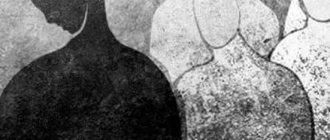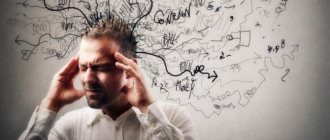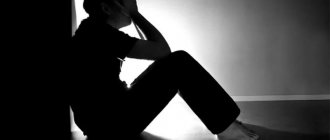Slava Profina 07/25/2018 no comments
3
A type of mental disorder on the neurotic spectrum, manifested in a pathological fear of worms and the ailments they cause, is scoleciphobia. Less commonly, phobia is considered as a symptom of fear of helminth infections and worms of various etiologies, often not only neurotic. According to the Diagnostic and Statistical Manual of Mental Disorders, family members of patients with severe scoleciphobia have an increased risk of developing the disease.
Varieties and causes of occurrence
According to research by psychiatrists, this disease is common in older people. In childhood, many people show interest in understanding the world, studying the surrounding plants and wildlife. Direct perception of the world around us protects children from imaginary fears. Kids often collect worms that interest them after the rain, examine them, and study them. Parents, as a rule, ask the child to remove this muck and, after thoroughly washing their hands with soap, never touch them again.
Feeling the mother’s disgust and fear of worms, the child adopts basic behavior patterns.
From this moment on, the first signs of the disease may appear. Also, the cause of the disease can be any strong emotional shock. For example, from the unexpected tactile sensation of a slippery body or accidentally seeing a picture of crushed caterpillars. Less often, scientists suggest a direct connection with the collective unconscious. In ancient times, worms had a negative response in various legends and myths.
The following types of scoleciphobia are distinguished:
- Scoleciphobia . Fear of worms, both real and graphic, and anything that superficially resembles a worm-like shape.
- Teniophobia . Fear of infection with parasitic worms, helminthiasis. A severe form of neurosis may develop.
- Verminophobia . Fear of infection and death due to maggot venom.
- A type of trypophobia . Panic disorder caused by cluster holes made by worms.
- Insectophobia . A particular type of fear of caterpillars and insects resembling them.
Scoleciphobia – fear of worms
There are many phobias associated with the fear of various insects - cockroaches, bees, ants, spiders, flies, centipedes and other similar creatures. Some people are afraid of worms. This disorder is called scoleciphobia. Let's figure out what kind of phobia this is, what are its causes and symptoms, and whether there are ways to get rid of it.
Where does fear come from?
It is difficult to find a person who would feel tenderness in front of worms. For many they cause a feeling of disgust and hostility. However, some individuals experience real horror from the mere sight of worms, let alone touching or handling them. This reaction indicates the presence of a phobia.
According to psychologists, scoleciphobia is not inherent in young children. Kids are rarely afraid of anything. They actively study the world around them, and their fears arise later - after receiving negative experiences.
Very often, small children collect earthworms on the street - they pick them up, examine them, study them, without experiencing any disgust. However, parents, fearing that the child will get sick, may forbid him to play with worms or even touch them. In this way, parents are able to instill in their child disgust, which can develop into a phobia.
The object of phobia is often not only different types of worms, but also leeches, caterpillars, slugs and other crawling invertebrates and their larvae.
In psychiatry, there are several types of phobias, similar to the fear of worms:
- Scoleciphobia is the fear of worms and other worm-shaped creatures.
- Verminophobia is the fear of contracting a serious illness from worms or dying from cadaveric poison.
- Teniophobia is a strong fear of infection with worms.
- Trypophobia is the fear of multiple holes and passages dug by worms.
- Insectophobia is the fear of insects.
Causes of scoleciphobia
There are several reasons that give rise to panic fear of worms:
- Upbringing . This reason has already been discussed above. If one or both parents experience fear or aversion to worms, then the child adopts this behavior pattern.
- Traumatic experience. Strong negative emotions associated with worms can leave a mark on the human psyche. For example, a person in childhood was frightened by the unexpected touch of a worm to the skin or saw a large accumulation of these creatures.
- Impressionability. Impressionable people can develop a phobia even without personal negative experience with worms. The sight of a decaying body infested with corpse worms can evoke strong emotions. Moreover, it is not necessary to see such a picture live. For an impressionable person, a film or photograph will be enough.
How does fear of worms manifest itself?
The disease can take different forms and manifest itself in different ways. In some patients, an attack of phobia occurs at the sight or direct contact with a worm. Others start to panic when they hear pests mentioned in conversation or just think about them.
In especially severe cases, a person is even afraid of objects infected with worms. There is a fear of touching open ground, water, grass. The patient is afraid to be in nature and in places where worms and other similar creatures can be found.
An attack of scoleciphobia is accompanied by the following symptoms:
- rapid heartbeat, heaviness or pain in the chest, shortness of breath, feeling of lack of air;
- digestive system disorder: nausea, vomiting, diarrhea;
- dizziness, headache, tinnitus, darkening of the eyes, disorientation;
- trembling hands, weakness in legs;
- increased sweating, dilated pupils;
- feeling of strong fear, panic, loss of self-control.
Depending on the severity of the disease, these symptoms vary in severity - from moderate to very severe.
How to overcome fear?
Any phobia must be treated, because it poisons a person’s existence, makes him inferior, and forces him to change his lifestyle. In addition, phobia often entails other mental disorders - neuroses, depression.
Only a few can cope with fear on their own. Other people have to seek help from a specialist. Psychotherapists and psychiatrists treat phobias.
Various psychotherapeutic methods are used to treat scoleciphobia:
- Psychoanalysis . During the session, the specialist, together with the patient, tries to find the true cause of fear. Most often it lies in childhood. The psychoanalyst asks the patient various leading questions, gradually bringing to the surface the fears hidden in his subconscious. This method is considered effective, although time-consuming.
- Hypnotherapy . The specialist puts the patient into an altered state of consciousness and begins to work with his deepest fears. As a result of suggestion, negative attitudes are replaced by positive ones, and the person gets rid of fear.
- Cognitive therapy. This method involves direct contact with the object of fear. The psychotherapist exposes the patient to interaction with worms, thereby helping his psyche develop a new defense mechanism and get rid of fear.
- Rationalization . Phobic fear itself is irrational. During therapy, the specialist appeals to the patient’s rational thinking, presenting information about the object of fear from a different angle. As a result, the patient begins to understand that worms are harmless and even useful creatures, and there is no need to be afraid of them.
If the phobia takes a severe form and affects the patient’s entire life activity, the doctor prescribes sedatives. Tranquilizers, antidepressants, and antipsychotics help cope with anxiety, relieve panic attacks, and normalize sleep and mood.
However, medications alone are ineffective. They are used as an addition to the main method of treatment. In addition, you cannot choose medications for yourself. This should only be done by a competent specialist. Self-medication with potent drugs will only worsen the patient’s condition.
In order to get rid of fear, the patient must make a lot of effort. Only in this case will he be able to say goodbye to his illness forever.
Source: https://KlopSOS.ru/nasekomye/skolecifobiya-bojazn-chervei-lichinok/
Symptoms and clinical picture
The sight of an object of phobia or something similar in appearance to a worm causes severe anxiety in patients. In most cases, the patient realizes that his fear is unreasonable and excessive. However, fear disrupts the usual way of life and causes an asthenizing effect. The asthenic effect manifests itself in the form of a painful condition, leading to increased fatigue and exhaustion of the body.
A characteristic feature of scoleciphobia - the so-called fear of worms - is the desire to avoid contact with a possible irritant as soon as possible.
The range of emotional reactions varies from mild nervousness in response to the actual presence of a worm to panic attacks provoked by a simple graphic image.
Physiological symptoms of fear of worms (phobias) include:
- attacks of dizziness and headache;
- digestive tract disorders: nausea, diarrhea, vomiting;
- surges in blood pressure and rapid heartbeat;
- dilated pupils or darkening of the eyes;
- noise in the head;
- tremor of the limbs;
- suffocation, lack of air;
- increased sweat production, especially in the palms.
Psychological signs include:
- feeling of anxiety and tension;
- anticipation of the development of negative events;
- increased sensitivity to environmental noise;
- loss of concentration;
- obsessive ideas about an unpleasant future.
Classic syndrome
As a syndrome, scoleciphobia and its common variant, helminthophobia, can be present in the development of diseases in various fields: psychosis and schizophrenia, alcoholism, hypochondriacal personality disorders, a side effect of long-term use of MAO inhibitors or methylphenidate.
The development of phobia is often found in patients who have already been cured of actual helminthiasis.
Helminthiasis is a parasitic disease of plants, animals and humans caused by parasitic worms. The weakened organism of the suggestible patient can provoke induced helminth phobia even after close communication with an authoritative person for the patient or reading media sources.
The syndrome may be accompanied by disturbances of perception (hallucinations and illusions) and thinking. In women, dermatozoal delusion is more common - a variant of tactile hallucinosis, a clinical form of psychosis, the victim of which is susceptible to delusional ideas about infection with parasites. Treatment of the syndrome is effective only in conjunction with therapy of the underlying disease. If you are convinced of a worm infestation, consultation with an infectious disease specialist is required to completely exclude it.
Features of treatment
If the phobia disrupts the usual way of life, then the patient should seek qualified help from specialists. When treating humans they use:
- Hypnotherapy. The doctor instills in the patient’s subconscious mind positive thinking and the perception of his fears. This is a complex technique with many nuances. The success of the session depends solely on the experience and professionalism of the hypnotherapist.
- Drug treatment. Used in cases of advanced anxiety, panic and depression. A benzodiazepine group drug can be prescribed by prescription from a psychiatrist. The main effect in this case comes from the process of inhibition of nervous excitation.
- Phytotherapy. The calming effect that people need when treating fears is achieved through a balanced intake of alcoholic infusions and decoctions of dill, lemon balm, hawthorn, peony and valerian.
- Behavioristic technique of “convergence”. Cognitive psychology involves achieving maximum effectiveness from doctor-controlled contacts with the object of a phobia. As a result, new psychological reactions to the stimulus must be formed.
- Art therapy. The patient is asked to make a detailed drawing of the object of anxiety or the most terrible fantasy associated with it. After a detailed analysis and discussion with a psychotherapist, the “ritual” destruction of the image is carried out. Clear associations are formed with the patient destroying his fears.
People have a variety of fears and anxiety states. But in cases where fear transforms into panic and the usual way of life is disrupted, a person needs to seek help from a psychotherapist.
3
How to get rid of a phobia of insects - insectophobia?
If insectophobia interferes with life, it must be treated. Do not be afraid to contact a specialist with your fear. It will help reduce the intensity of fear, help you see danger only where it really exists, using cognitive behavioral therapy methods.
When treating insectophobia, cognitive behavioral therapy is the most effective.










